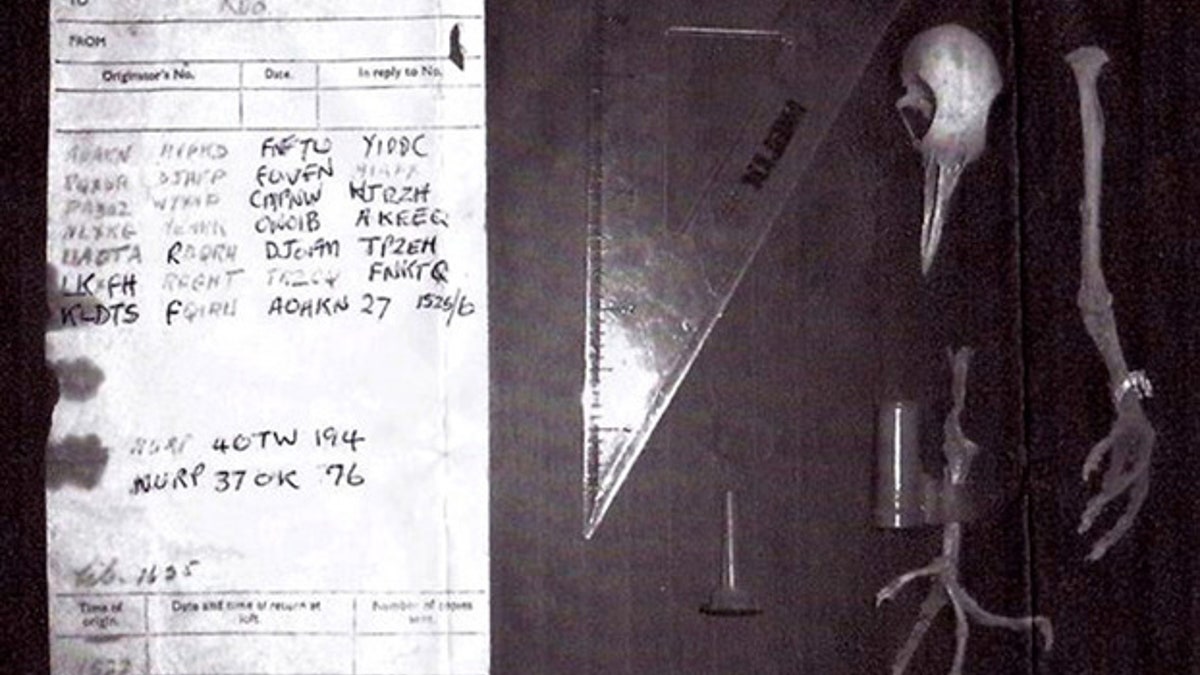
(Discovery)
British intelligence agents are working on deciphering a coded message that has remained a secret for nearly 70 years -- attached to the leg of a hero World War II carrier pigeon.
Found in the chimney of 17th-century home in Bletchingley, Surrey, the bird's skeleton was found in 1982 when the home's current owner David Martin decided to restore the fireplace.
"I started finding bits of a dead pigeon. We thought it might be a racing pigeon until we spotted a red capsule," Martin told reporters.
The small red cylinder contained a mysterious cigarette paper-sized encrypted message.
PHOTOS: Cryptic Codes Yet to Be Cracked
Unseen for three decades, the message "is deemed so sensitive, that codebreakers at GCHQ (Government Communications Headquarters) are now frantically trying to decipher it," Bletchley Park, a center where during World War Two top secret codebreaking work was carried out on behalf of the Allies, said in a news release.
Experts realized the bird was named 40TW194 from the aluminum ring found on its leg (the first two numerals indicate the pigeon's year of birth).
Almost certainly, the carrier pigeon was dispatched from Nazi-occupied France on June 6 1944, during the D-Day Invasions.
Because of Churchill's radio blackout, homing pigeons were taken on the D-Day invasion and released by Allied Forces to inform military generals back on English shores how the operation was going.
The military pigeons were dropped behind enemy lines from bombers, whereupon resistance fighters picked them up, before releasing them homeward bound with top secret messages.
The brave birds played a very active role in World War II (the RAF trained 250,000 birds, forming the National Pigeon Service) and, between 1943 and 1949, 32 were awarded the Dickin Medal, Britain's highest possible decoration for valor given to animals.
ANALYSIS: Do Mona Lisa's Eyes Hide a Secret Code?
Among the 32 feathered heroes are "Mary of Exeter," which received 22 stitches after being injured in the course of her duties and "GI Joe," an American pigeon whose message saved more than 1,000 lives as it prevented bombing on a village that it had actually been recaptured by British forces.
Pigeon enthusiasts are now calling for 40TW194 to be posthumously decorated with the Dickin Medal.
The British spy pigeon either got lost, disorientated in bad weather, or was simply exhausted after flying for hundreds of miles. Experts speculate the bird might have attempted to rest on an open chimney, but was overcome by fumes from a fire below and he died.
Most likely, 40TW194 was destined for the top secret Bletchley Park, which was just 80 miles from Martin's home. Now a museum, Bletchley Park is where codebreakers worked around the clock to crack the Nazi's "unbreakable" Enigma code.
"The message Mr Martin found must be highly top secret. We have more than 30 messages from WWII carrier pigeons in our exhibition, but not one is in code," Colin Hill, the curator of Bletchley Park's "Pigeons at War" exhibition, said.
"We know it's an Allied Forces pigeon because of the red capsule it was carrying -- but that's all we know," he added.
The message was sent to XO2 at 16:45 and contain 27 codes, each made up of five letters or numbers.
NEWS: Breaking the Code: Why Yuor Barin Can Raed Tihs
The destination X02 is believed to be Bomber Command, while the sender's signature at the bottom of the message reads "Serjeant W Stot."
[pullquote] "It's a real mystery and I cannot wait for the secret message to be decoded," Martin said.
He had previously showed the encrypted message to the late British spy and intelligence officer Wilfred "Biffy" Dunderdale, who is said to have been the real-life inspiration for his friend Ian Fleming's fictional spy James Bond.
A specialist in counter-espionage, Biffy coincidently lived near Martin's house after the war.
"When I showed him the bird and code, the blood drained from his face and he advised us to back off," Martin said.
"He said nothing would ever be published," Martin added.
